The cavity reactivity of the coolant and the coefficients of thermal expansion are the critical parameters in fast reactor core design that determine the safety of the core. The core performance of the final core design was evaluated and the operational feasibility was assessed in a neutronic point of view.
INTRODUCTION
Next Generation Reactors
As the nuclear power plant develops, the development of the next generation of nuclear reactors becomes an important task to prepare. SFR) is one of the six Gen-IV reactor concepts and it is the most nearly deployable reactor concept with its technological maturity and operational experience in the world.
![Figure 1. 3. Six reactor types for Generation IV nuclear reactor [4].](https://thumb-ap.123doks.com/thumbv2/123dokinfo/10529347.0/18.892.109.799.213.615/figure-1-reactor-types-generation-iv-nuclear-reactor.webp)
Advanced Reactor Concept Proposal
The IAEA estimates that it would be a market close to $350 billion and a trillion dollar corresponding market would be possible.
Objective and Scope
METHODOLOGY AND TOOL
Steady-state Analysis
- McCARD
- MC 2 -3/TWODANT/REBUS-3
A nodal method has been added to the DIF-3D code to improve the efficiency of reactor geometries. In order to ensure the compatibility of using both McCARD and MC2-3/TWODANT/REBUS-3 models for the same basic model, the behavior of the multiplication factor was compared with respect to burn-up and the result presented in Figure 2.2.
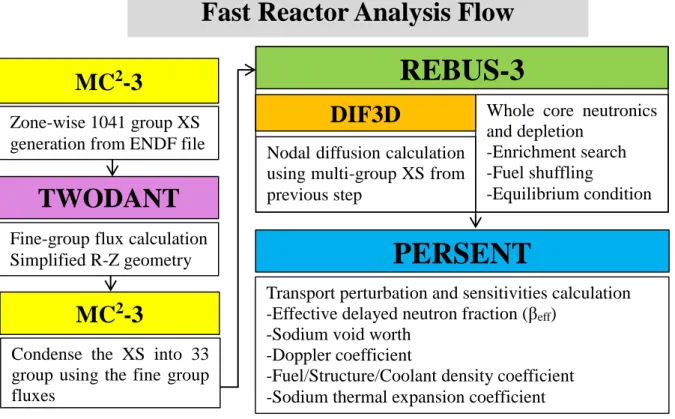
Transient Analysis
- Anticipated Transient without Scram (ATWS) Analysis
- Quasi-static Reactivity Balance
- SAS4A/SASSYS-1
During ATWS liquid metal cooled fast reactor (LMR) can be affected by some parameters in the external events and the most important parameters are coolant inlet temperature, coolant flow rate, external reactivity change due to control rod movement, and external reactivity change due to geometry seismically altered. B has some additional terms due to sodium density, thermal expansion above core charge pad (i.e. core radial expansion), and control rod driveline expansion and multiplied by the mean coolant temperature rise relative to the inlet coolant temperature.
![Table 2. 1. Cause and effect of UTOP [18].](https://thumb-ap.123doks.com/thumbv2/123dokinfo/10529347.0/25.892.105.800.131.1119/table-2-1-cause-effect-utop-18.webp)
Spent Fuel Utilization
It contains mechanical models of transient thermal, hydraulic, neutronic and mechanical phenomena to describe the response of the reactor core with its coolant, fuel and structure to given transient conditions. For this thesis research, mini version of SAS4A/SASSYS-1 (mini-SAS) was used to evaluate the safety features of the newly developed reactor core.
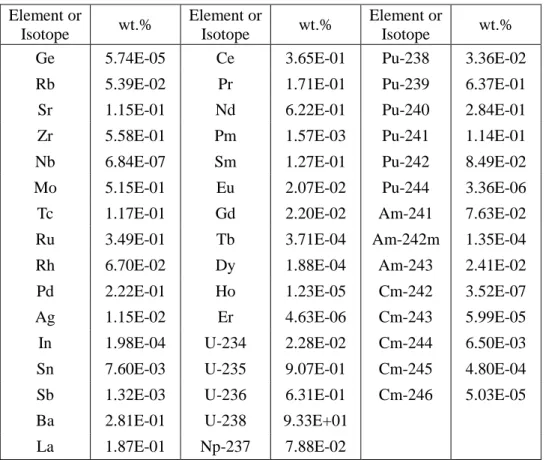
CORE DESIGN STRATEGY
Fast Reactor Design
- Major fast reactor physics
- Safety characteristics
The Ultra-Long Cycle Fast Reactor (UCFR) was developed with a 60-year operation in mind and has a capacity of 2600 MW (thermal). The metallic fuel is the most important design option for the fast reactor due to the higher breed rate achievable than any other form of fuel, as shown in Figure 3.5.
![Figure 3. 2. Neutron energy spectrum according to the fuel and reactor type [32].](https://thumb-ap.123doks.com/thumbv2/123dokinfo/10529347.0/33.892.110.775.552.946/figure-neutron-energy-spectrum-according-fuel-reactor-type.webp)
Small Modular Reactor Design
FEASIBILITY OF LONG-CYCLE OPERATION SM-SFR
Assessment of Long-cycle Fast Reactor Core Concepts
- CANDLE
- SMFR
- UCFR
This process occurs continuously along the fuel in the axial direction with the active propagating core which can be identified by the movement of the neutron flux peak. The spreading behavior of the CANDLE core can also be confirmed through the evolution of the axial power profile as shown in Figure 4.5. A conceptual 4S (Super-Safe, Small and Simple) reactor design was proposed by Toshiba and CRIEPI in Japan to meet the following design requirements: (1) All temperature response reactivity coefficients including the reactivity of all sodium gaps are negative; (2) the integrity of the core is assured against all anticipated non-scratch passages of the reactor; (3) neither emergency power nor an active mitigation system is required; (4) the essential life is more than 10 years.
The thick line in Figure 4.11 is the effective neutron multiplication factor of the bare core without reflector or absorber rod. The 4S achieves active core movement by adopting a movable reflector instead of the concretion and combustion strategy. Since the geometrical and material information of the fixed hafnium absorber is not presented in Ref.
In this figure, the nuclide transmutation can be well noted by comparing the densities in the upper and lower parts of the neutron flux peak.
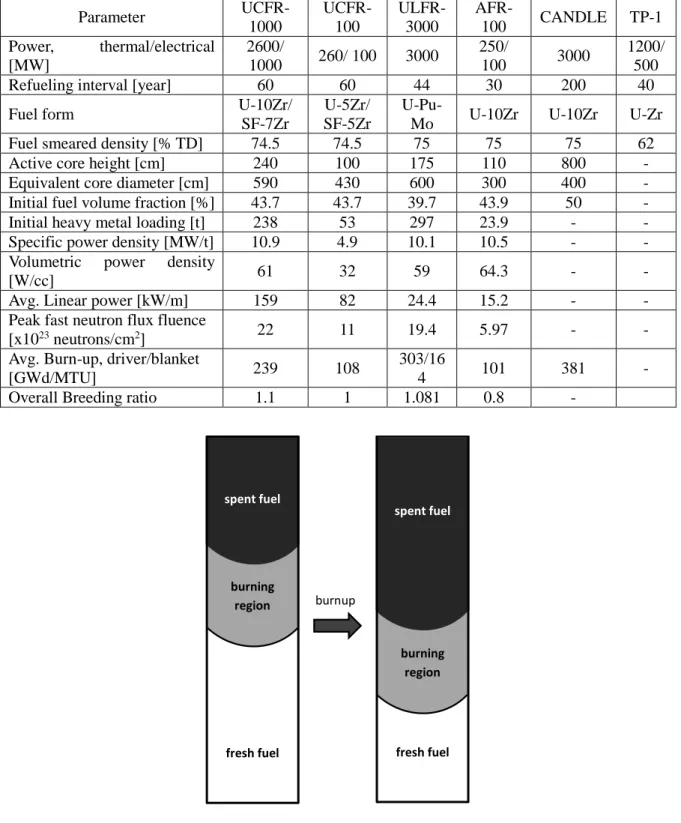
Assessment of Material Performance
- Fuel: Fertile
- Fuel: Fuel type
- Coolant
- Reflector, clad and structure
As a result, the effective delayed neutron fraction of thorium-based fuel is smaller than that of uranium-based fuel. As a result, thorium-based fuel has less of a positive spectral effect compared to uranium-based fuel in a fast reactor. The retarding power of most fast reactor materials is less than 1% hydrogen in a PWR.
Metallic fuel with zirconium is the most beneficial among them, except for the fact that it has the lowest melting point. With a normalized neutron flux and additional flux plot, Figure 4.23 shows that metallic fuel has a harder neutron spectrum than any other type of fuel. This table was made in the accident analysis of a lead or LBE cooled small long life fast reactor.
It is noted that the trapping and scattering cross section of LBE is larger than that of sodium as shown in Figure 4.27 and Figure 4.28.
![Table 4. 8. Liquid metal cooled small modular reactors [6].](https://thumb-ap.123doks.com/thumbv2/123dokinfo/10529347.0/58.892.97.800.184.419/table-4-liquid-metal-cooled-small-modular-reactors.webp)
DEVELOPMENT OF ADVANCED SM-SFR
Design Requirement
- Reactor
- Core
The SMFR uses 2 units of the electromagnetic pump, and the SM-SFR is expected to have 1 or 2 units of the electromagnetic pump due to its power level of 50~100 MWe. The Brayton cycle has been estimated to have a thermal efficiency of about 45%, which saves more than $40 million each year compared to the Rankine cycle. For the forward-looking reactor concept developed in this study, the Brayton cycle is valuable enough to be adopted.
The Brayton cycle with supercritical carbon dioxide is the most prevalent fluid, but nitrogen also deserves careful consideration in future studies. As a result of the basic design strategy study in Chapter 3, zirconium-uranium metal fuel and sodium coolant are expected to be appropriate for this core design. Most parameters of SM-SFR are similar or less than UCFR-100 and CEFR and PFBR would be the lower and upper bounds, respectively.
Power density is related to core depletion characteristic, temperature distribution, cycle length, core compactness, etc.
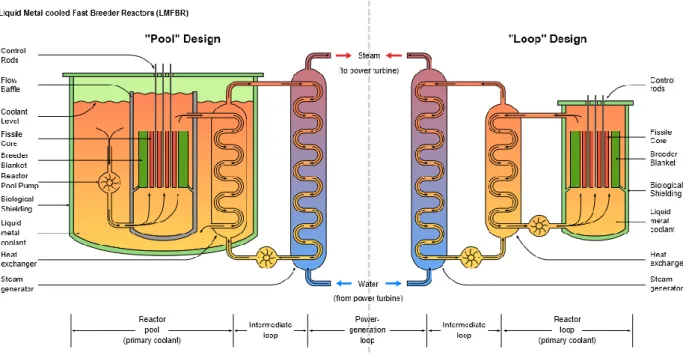
Core Design Study
- Pin & assembly design parameter
- Core design parameter
- Breed-and-burn strategy
- Sensitivity study of breed-and-burn strategy
The blanket area is located in the center of the core and the burner area surrounds it. This core is based on the CANDLE reactor, so the blanket area is located on top of the core. The blanket region is located in the center of the nucleus, axially surrounded by the upper and lower LEU regions.
At the beginning of the nuclear lifetime, active nuclei are formed in the LEU regions. In this sensitivity analysis, the nuclear lifetime was extended by increasing the enrichment of the radial breeding nucleus. Sensitivity analysis was performed by increasing the area or height of the blanket region in the onion zonation core.
The fluctuation of reactivity becomes smaller as the height of the blanket region increases.
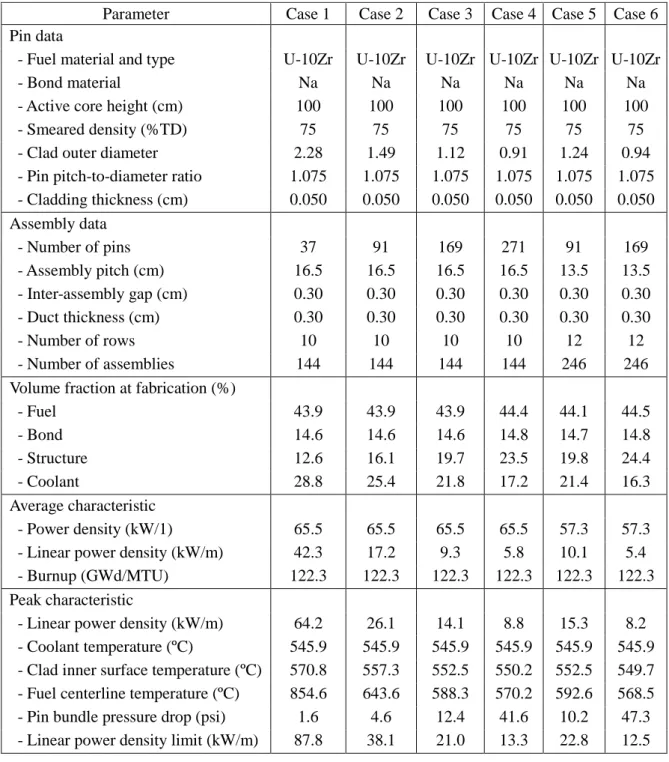
Final Core Design
In the case of adding 13.8% enriched uranium, the reactivity swing was reduced while the lifetime was similar. The configuration of the SM-SFR is a regular pool-type reactor, but the arrangement of the components in the reactor vessel is similar to that of the SMART.
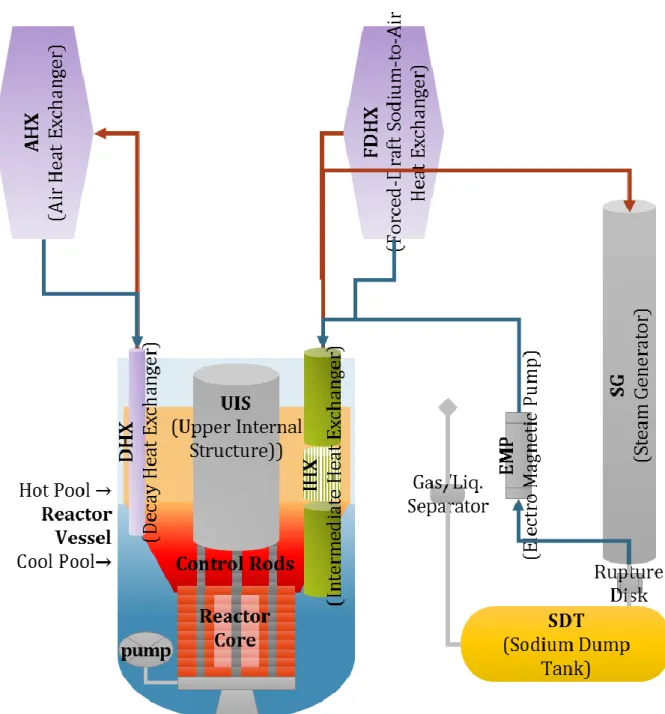
PERFORMANCE EVALUATION OF SM-SFR
Depletion Behavior
- Multiplication factor
- Conversion ratio
- Mass flow
- Power distribution
- Neutron balance
- Kinetics parameters and reactivity feedback coefficients
- PWR spent fuel loading in blanket
In this study, the enrichment ratio is defined by the ratio between the fissile material mass at discharge and the mass at charge. Along the depletion, breeding occurs at the blanket region and the active core moves into the center of the core. And Figure 6.4 shows the axial power distributions of the active core at BOC, MOC and EOC.
Since the blanket region is located in the center of the core, the active core does not move axially and the axial power distributions are almost stationary in shape. As combustion proceeds, the leakage decreases relative to the expansion of the active core and the sodium vacancy value becomes less negative. The coefficients of radial and axial expansion for each condition are negative values, which predominantly contributes to the inherent safety of the core.
As shown in Figure 6.5, the spent fuel cladding with the same proportion of zirconium has a higher reactivity in the initial state, but shows a steeper decrease in multiplication factor behavior than that of the natural uranium cladding, leading to a shorter operating time.
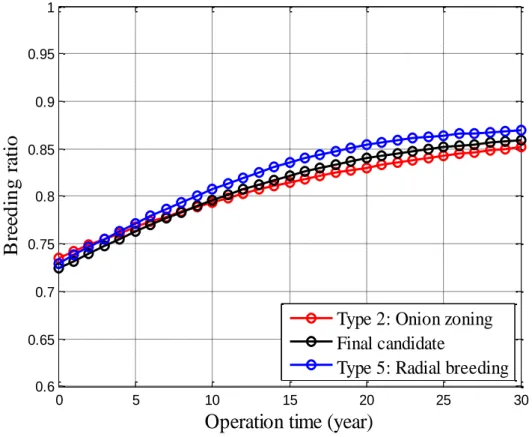
Safety Analysis
- Control system
- Quasi-static reactivity balance
- ATWS analysis
It is necessary to distribute the joystick in the value of the primary and secondary systems. Furthermore, it is impossible for the secondary rod to have enough value in the center of the core at BOC, even with enriched boron, due to the location of the active core. This is because the effect of the center joystick becomes dominant after MOC due to the change in the location of the active core.
For this study, the stopping limit for configuration-B.1 was estimated based on the compliance of the core geometry. For the reactivity error from the critical position, the value of the most reactive primary rod was measured according to the position of the rod from the bottom to the top of the core, as shown in Figures 6.10~12. The logic for calculating the maximum fast reactor rod value requirement and uncertainty values are available in references 1–3.
For the UTOP event, the programmed reactance of 30¢ is inserted linearly over 15 seconds and remains until the end of the transient, as shown in Figure 6.24, which simulates a control stick pullout due to an accident.
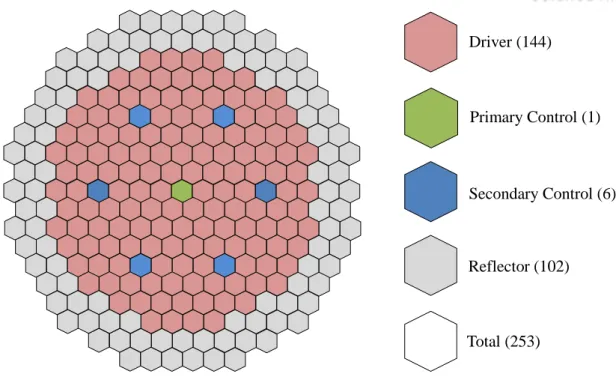
CONCLUSION
The feasibility of the ultra-long cycle operation was first confirmed by the multiplication factor trend and its reactivity swing for each case. From a sensitivity study of the enrichment and amount of carpet in each breeding case with some combinations of them, an optimized race-and-fire model was drawn to be used for SM-SFR. It breeds from the periphery to the center of the core mainly in the radial direction, and the conversion ratio is close to 0.75, and it increases to 0.85 when the active core moves to the blanket region.
To ensure the inherent safety of the newly developed SM-SFR, the safety analysis was carried out. First, the control rod system was optimized by the configuration change of the control rods for both primary and secondary systems, and the shutdown margin was calculated based on the available reactivity value and the maximum requirement. The integral reactivity parameters are all negative, and the calculation result of the quasi-static reactivity for the three ATWS events satisfies each of the criteria.
The intrinsic safety of the core was assessed by the transient analysis also using a thermal-hydraulic and neutronic analysis code for current and flow transient.
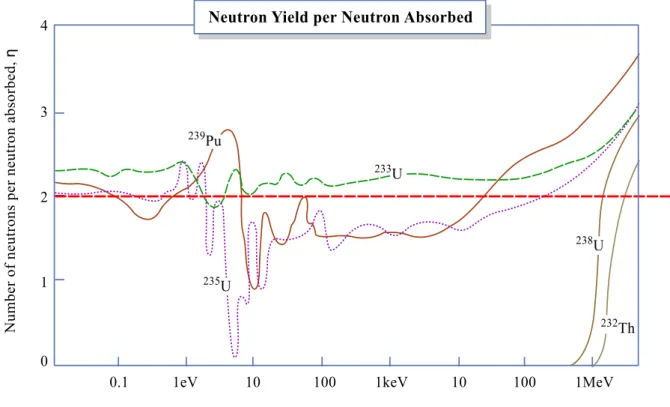
![Figure 3. 4. Fission cross section of major fertile isotopes in fast reactor [34].](https://thumb-ap.123doks.com/thumbv2/123dokinfo/10529347.0/35.892.111.783.649.1078/figure-fission-cross-section-major-fertile-isotopes-reactor.webp)
![Figure 3. 5. Comparison of breeding ratio potentials of oxide, carbide, and metal fuels [35]](https://thumb-ap.123doks.com/thumbv2/123dokinfo/10529347.0/37.892.254.640.133.649/figure-comparison-breeding-ratio-potentials-oxide-carbide-metal.webp)
![Figure 3. 6. Asymptotic temperature reached during ULOF: comparison of oxide and metal cores [36]](https://thumb-ap.123doks.com/thumbv2/123dokinfo/10529347.0/38.892.116.802.353.821/figure-asymptotic-temperature-reached-ulof-comparison-oxide-metal.webp)
![Figure 3. 7. Components of sodium void coefficient for a small cermet-fueled SFR [37]](https://thumb-ap.123doks.com/thumbv2/123dokinfo/10529347.0/39.892.294.595.124.531/figure-components-sodium-void-coefficient-small-cermet-fueled.webp)
![Figure 4. 2. Flux and number density variation in small long life CANDLE reactor [42]](https://thumb-ap.123doks.com/thumbv2/123dokinfo/10529347.0/42.892.113.792.132.549/figure-flux-number-density-variation-small-candle-reactor.webp)
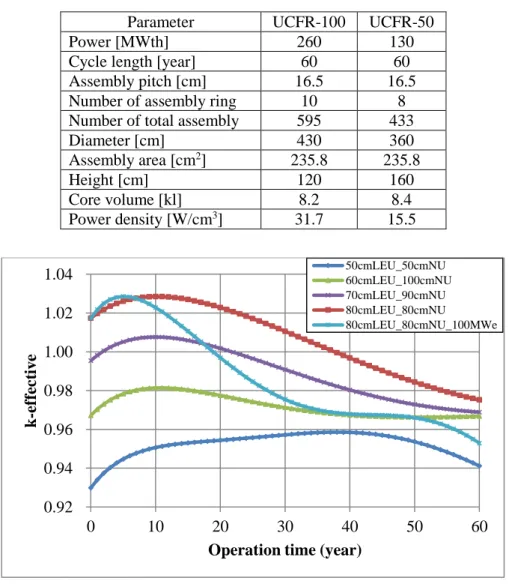
![Figure 4. 23. Typical neutron flux and adjoint flux spectrum according to fuel type [56]](https://thumb-ap.123doks.com/thumbv2/123dokinfo/10529347.0/63.892.117.791.133.588/figure-typical-neutron-flux-adjoint-flux-spectrum-according.webp)
![Figure 4. 24. Change in reactivity component during ULOF accident at BOC for metal fuel (left) and nitride fuel (right) [57]](https://thumb-ap.123doks.com/thumbv2/123dokinfo/10529347.0/64.892.125.784.126.434/figure-change-reactivity-component-ulof-accident-metal-nitride.webp)